Get Creative in Drawing Ornaments!
This month, the focus is on art history. Art history is often talked about in a very serious tone, but let’s examine it through imagination and start by drawing ornaments!
Ornament Tells a Story from Childhood
It’s fascinating that even if the ornaments are stiff and organized compositions, one can express a whole story.
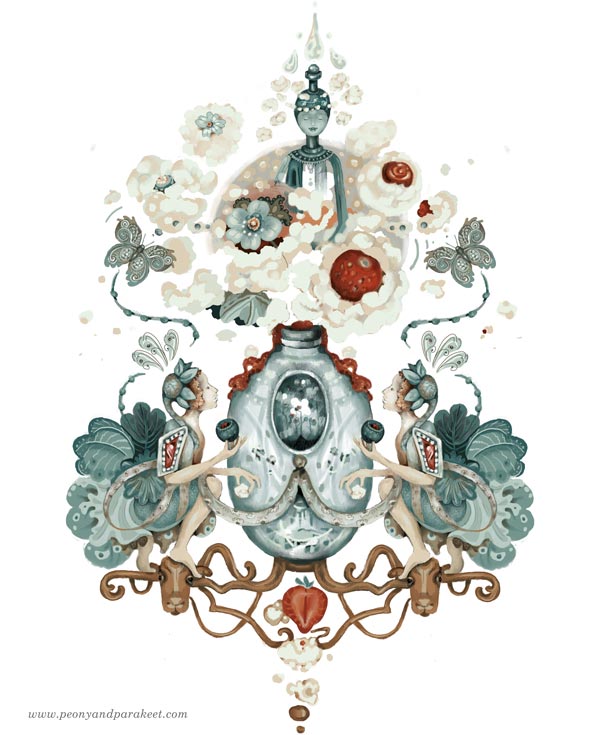
The background of this drawing is a funny story from my childhood. When the school asked each student’s favorite food, I answered “Mansikoita ja kermavaahtoa!” – Strawberries and whipped cream” while the others listed macaroni dishes or meatballs. Both the teacher and the students were quite shocked by the answer, but I wondered how anyone would prefer to eat something so modest and usual.
This story tells a lot about how I’ve always wanted to get away from the mundane. I still want to draw things so that they look like a luxurious celebration rather than a gray everyday life. I like drawing jewels, lace, floral motifs, and swirls, and you can have a lot of those on the ornaments.
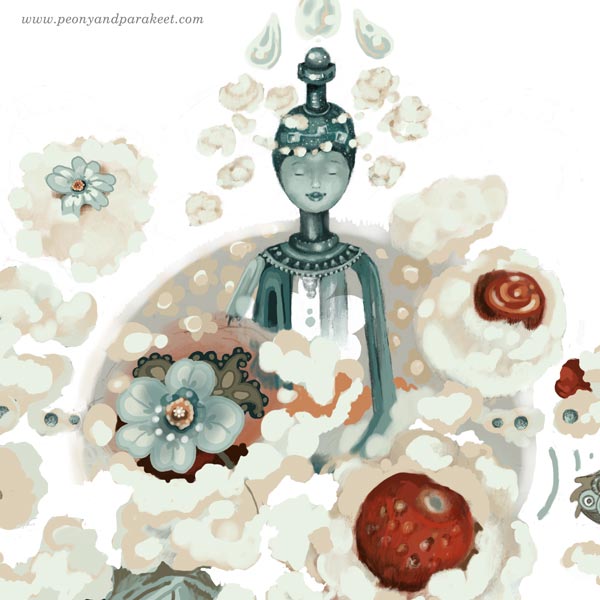
I often want to include people or animals too. For example here, I wanted to make the whisk half-human, and draw two fairies that enjoy the dessert.
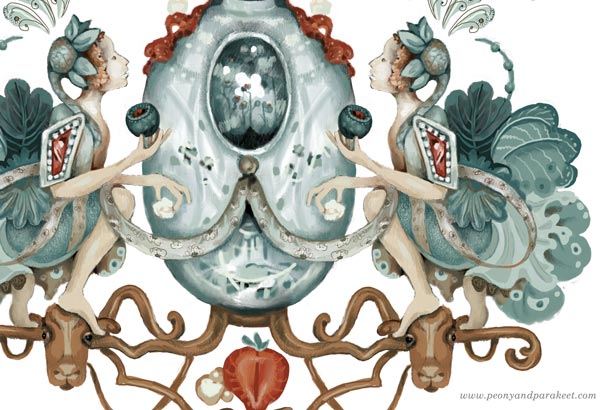
The method that I teach for human poses in the course Doll World was very helpful here.
Inspiration from Antiques, Old Buildings, and Paintings
There are plenty of ornaments in my photo archive. When I visit old buildings, I go through doors, ceilings, wall panels, and floors, looking for nice ornaments.
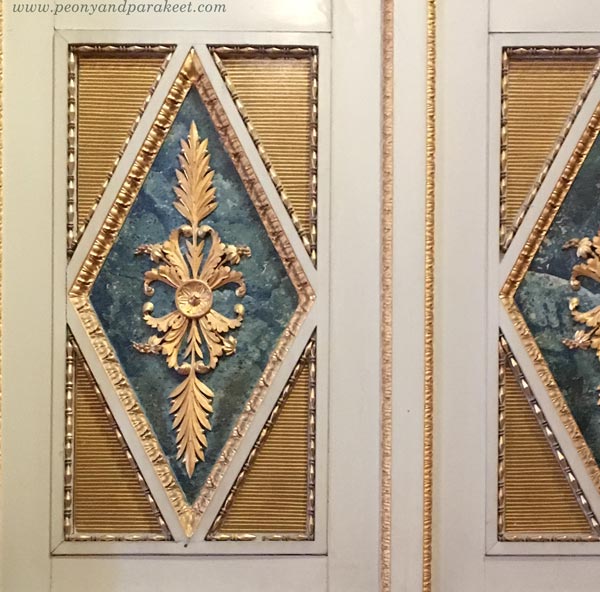
I also love to examine antiques closely.
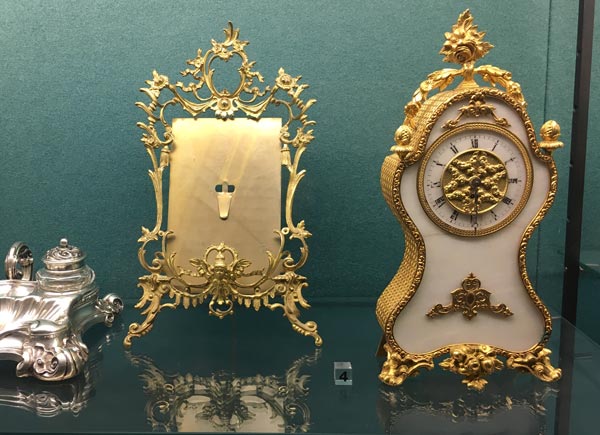
Old paintings often have lovely frames. Whenever I photograph one, I always try to include the frame in the picture.
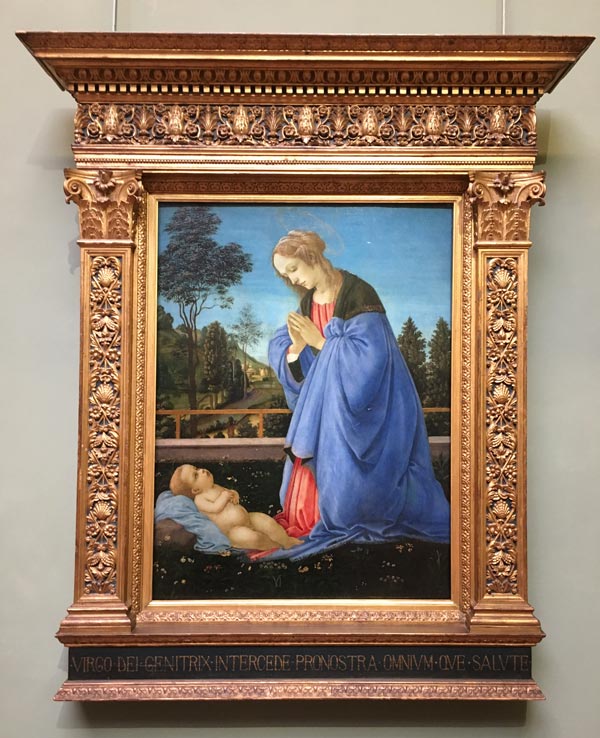
This frame is like an ornament representing a palace!
Lots of Simple Shapes
The decorative appearance of the ornaments can mislead you into overestimating their complexity. When an ornament is taken apart, the shapes can be quite simple.
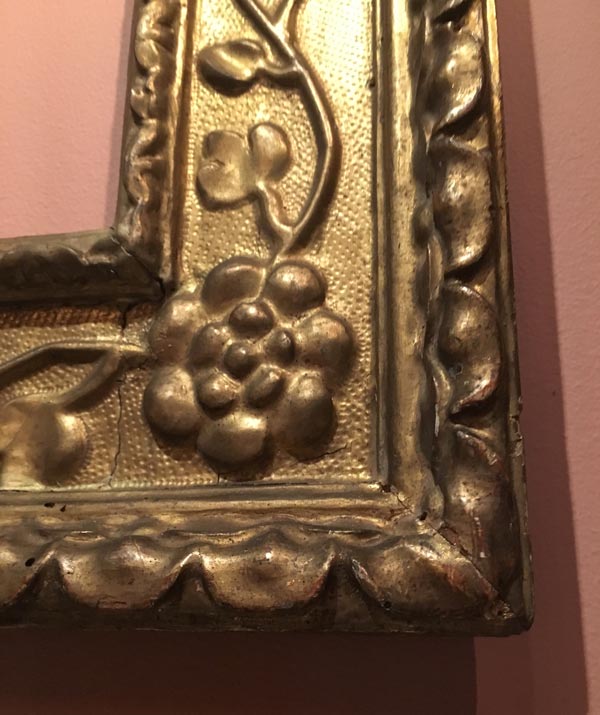
I love this kind of sophistication based on quantity and repetition, with which you can express anything – humorous subjects …
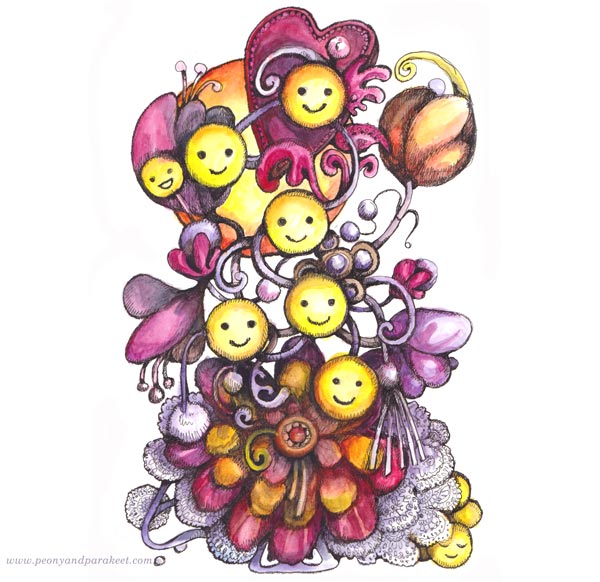
… or more serious.
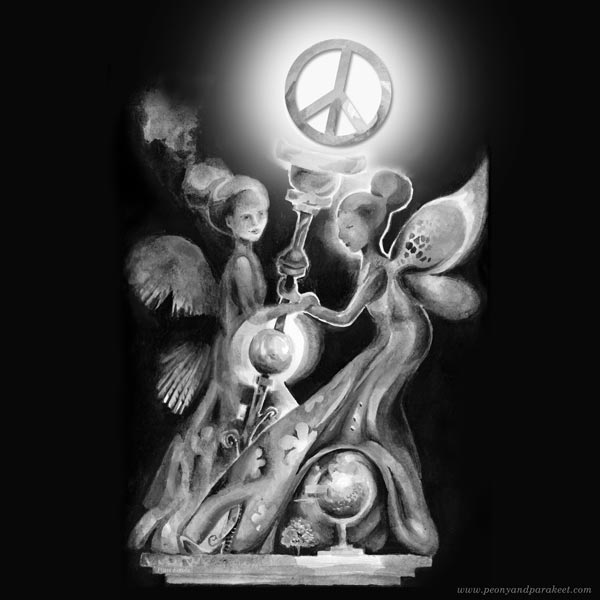
This example shows well that you can also express light when drawing ornaments.
Ornaments Can Both Hide and Reveal
I am fascinated by the fact that although the subject can be drowned in decorative forms, it can also be brought out more directly and more concisely than in a regular drawing. Time travel to the past can become surreal when the horizon disappears and the items are arranged as part of a floating structure.
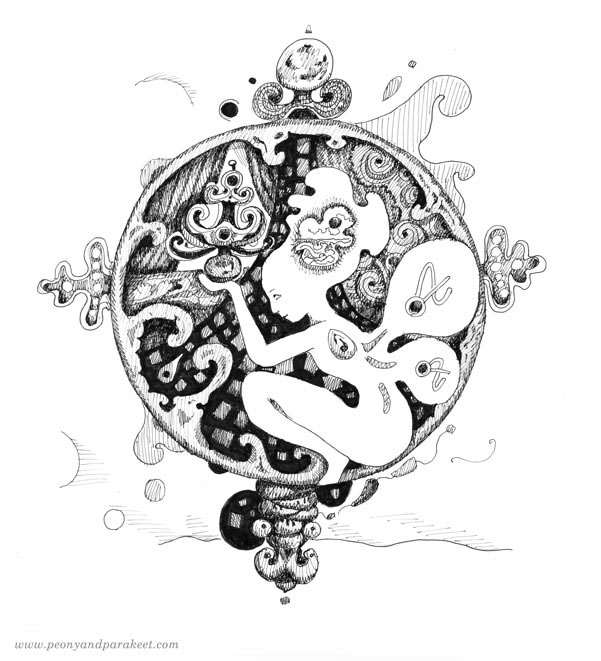
Ornaments as Collage Art
If drawing the whole ornament in one go feels too demanding, remember that the ornaments can also be collage art. You can glue individual elements so that they form a decorative tree or medallion. I have put together many kinds of ornaments from hand-drawn animals and hand-decorated papers.
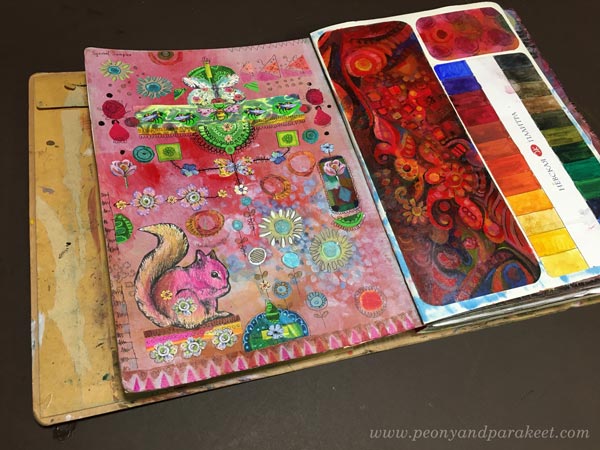
You can also scan or photograph the drawings and assemble the ornament digitally with an image processing program. Here are animal figures and flowers from the course Animal Inkdom and a teacup from the course Magical Inkdom.
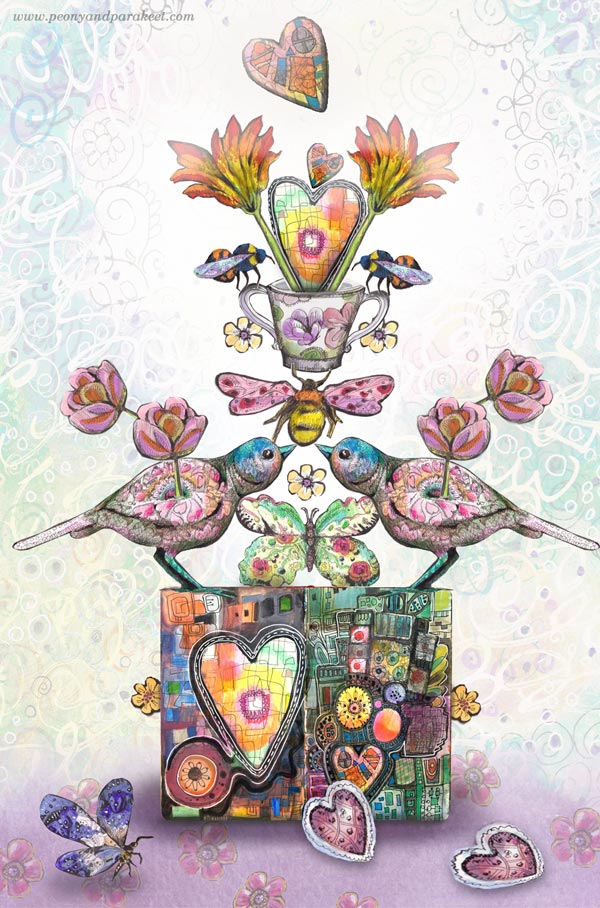
Drawing Ornaments is Expressing the World
After working with ornaments for a while, you begin to realize that the world is largely based on them. Surface patterns are everywhere. The beauty of organic forms can be found in all living things.
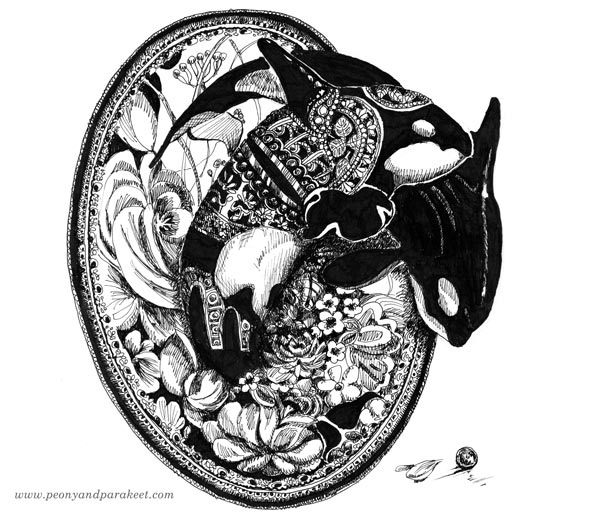
Ornaments build a bridge between the living and the non-living. They make the living an object and the object alive.
Hidden Love for Ornaments and How it Shows
I think that many of us have an innate need to design ornaments. Maybe you dream about designing fabrics or have a huge stash of them. Maybe you collect jewelry or save photos of them. Maybe you feel that something is lacking if you only draw or paint complete images and are not able to rearrange the composition so that it’s something more stylish and less representational.
I only realized this tendency of mine when I made ornaments as part of the illustration for a children’s book. Back then, I used transparent marker paper to design the symmetry, and my desk was full of different versions.
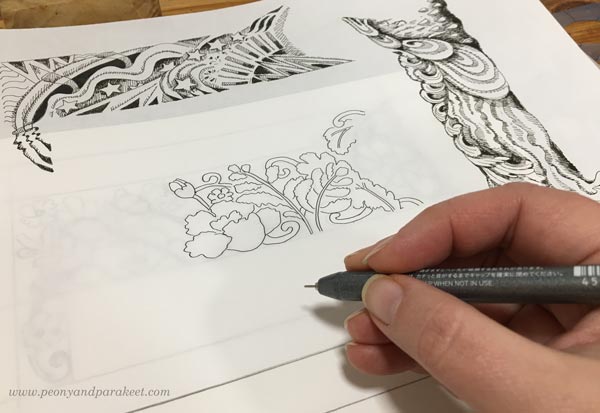
One day when picking the pen, I suddenly felt happy and meaningful: “I should do this more!” Since then, I have not underestimated even the smallest encounters with ornaments.
Drawing Ornaments Inspired by Embroidery
I relax from my work as an artist by doing cross-stitch and those projects also inspired me to draw ornaments.
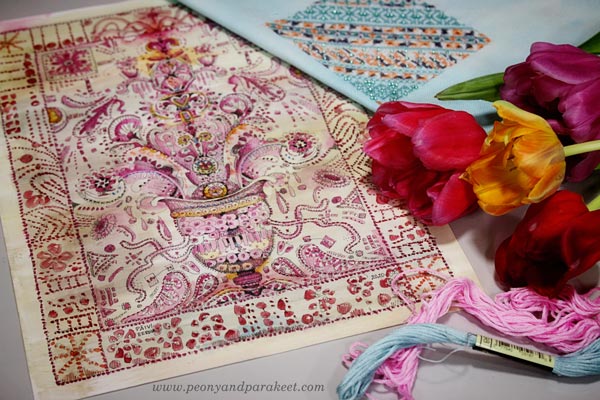
See here how to draw and color an embroidery-inspired ornament – Doodler’s Sampler Step by Step!
Drawing Ornaments without Perfect Symmetry
I drew the last ornament with the ProCreate app. The good things about it are that the background can be kept separate so that the background colors can be varied and it is easy to create symmetry. However, I think completely symmetrical ornaments are a bit too stiff and boring, so I also made quite a lot of asymmetry for this ornament.
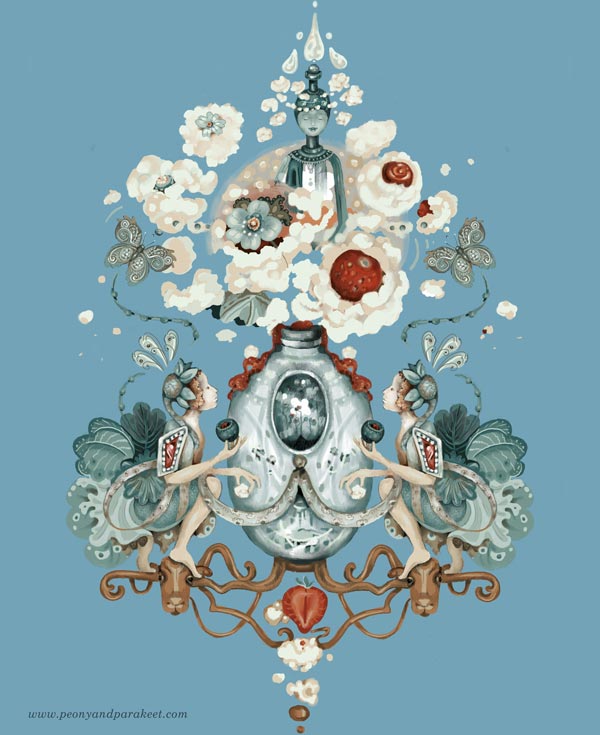
I hope you will start drawing ornaments right away whatever technique you choose!
Related Courses
- Doll World – drawing human poses – Buy here!
- Animal Inkdom – drawing animals – Buy here!
- Magical Inkdom – drawing fantasy – Buy here!
- Collageland – inspired by embroidery – Buy here!
Wonderland Art – Inspiration from Alice in Wonderland
Last fall, I was asked to participate in a small gallery exhibition called Kaninkolo (Rabbit Hole). I thought that the name was a funny reference to the Alice in Wonderland book and an opportunity to create fantastic wonderland art. I had previously covered the wonderland theme by drawing for the Magical Inkdom course. It was fun to see how the theme would lend itself to my painting style, which is much more abstract.
Wonderland Rises From the Dark

For me, wonderland art calls for dark colors. I’ve seen Tim Burton’s movie Alice in Wonderland and I think it has some wonderfully gloomy scenes. I would really like to paint dark paintings because exciting things can happen in the dark. However, I try to curb this desire, because Finnish homes are light and light paintings sell better!
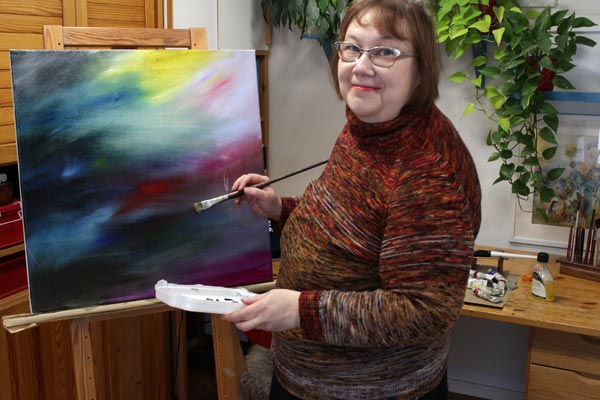
But now I got permission from myself to paint one dark painting, in which I also rejoiced with colors.
New is a Wonderland
I started with confidence, but at some point in the frenzy of painting, I stopped: “Could I paint so boldly? Should I tone down a bit?” But then the painting replied: “Päivi, don’t be afraid in wonderland!”
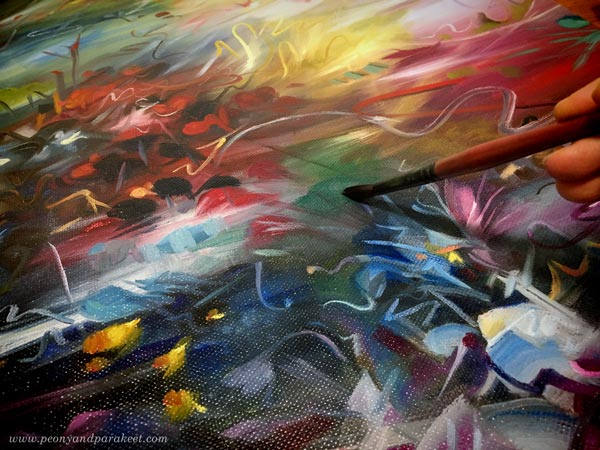
And yes, whenever we are on the verge of something new, we are a bit like Alice in Wonderland. Then you just have to keep experimenting and painting. I admire brave people and I would like to paint with courage. It’s not always possible to do that, but I’m going to continue to let loose from time to time!
Wonderland Art – Queen, Alice, and Others
This “Don’t Be Afraid in Wonderland” piece was really fun to paint. Among the characters in the book, my favorite is the Queen of Hearts. Of course, Mad Hatter also had to be painted.

I also included Cheshire Cat, as well as the twins Tweedledee and Tweedledum.

In this painting, Alice is a flying flower!
Wonderland Art – Wheel of Fortune
When I started building the Magical Inkdom course in 2019, one of my first drawings was this Wheel of Fortune.
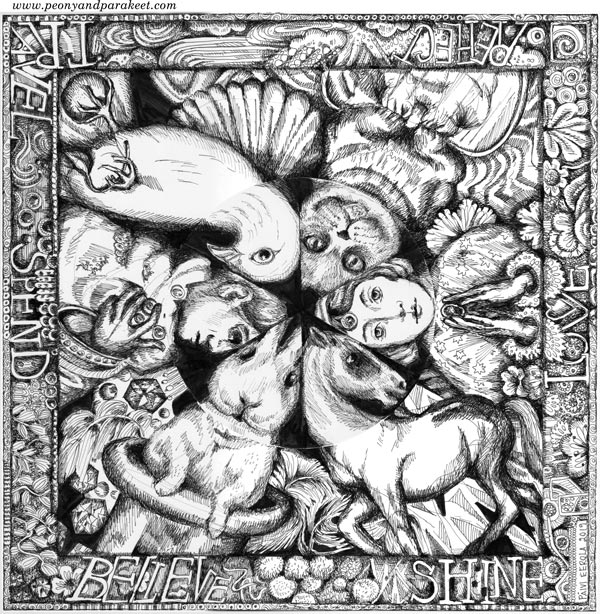
When drawing all the details, I thought about how I would divide the lessons. I got the idea to make a separate central circle for the drawing, which can be rotated and thus change the heads and outfits of the characters. You can see the wheel at the end of this video:
Drawing a gameboard with a wheel helped me to come out with the idea of playing cards and a bag for storing them.
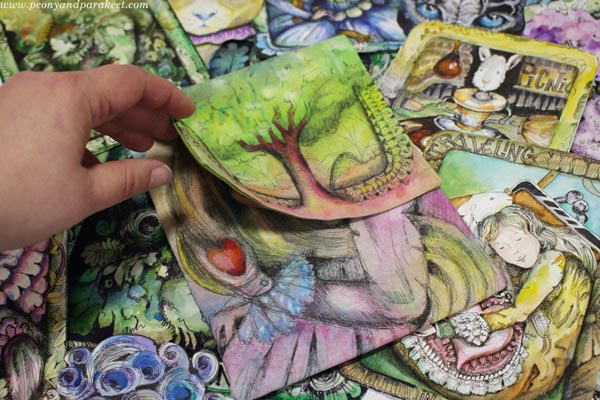
So when I went more abstract and thought about the concept of the wonderland, it fed ideas for several lessons.
Moving from Wonderland Characters to Wonderland Mood
Lately, I’ve been thinking a lot about the differences between representational and abstract and what can be expressed with abstract imagery. For example, could I paint an abstract outdoor tea party?
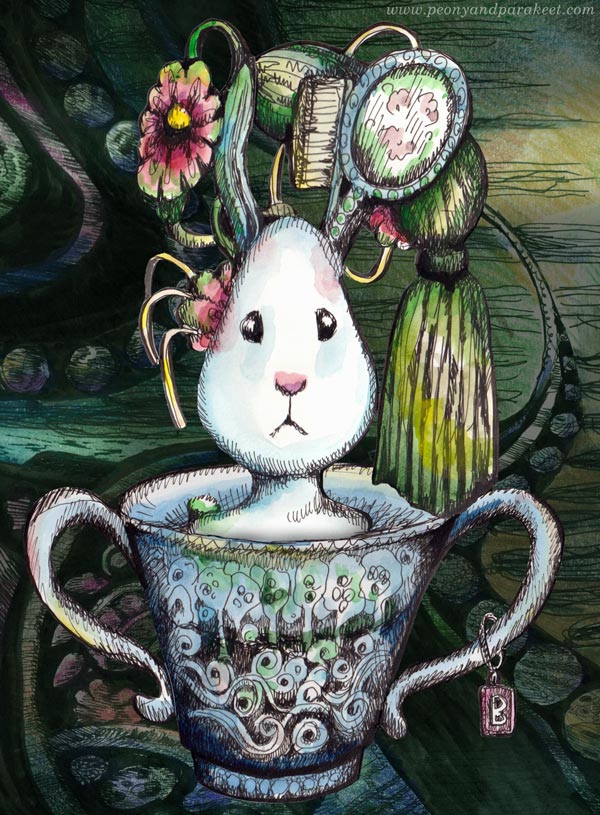
I saw the arbor and the delicate porcelain cups in my mind, but could I detach the motifs from the cups and fly to the place as a magician who removes the excess realism?
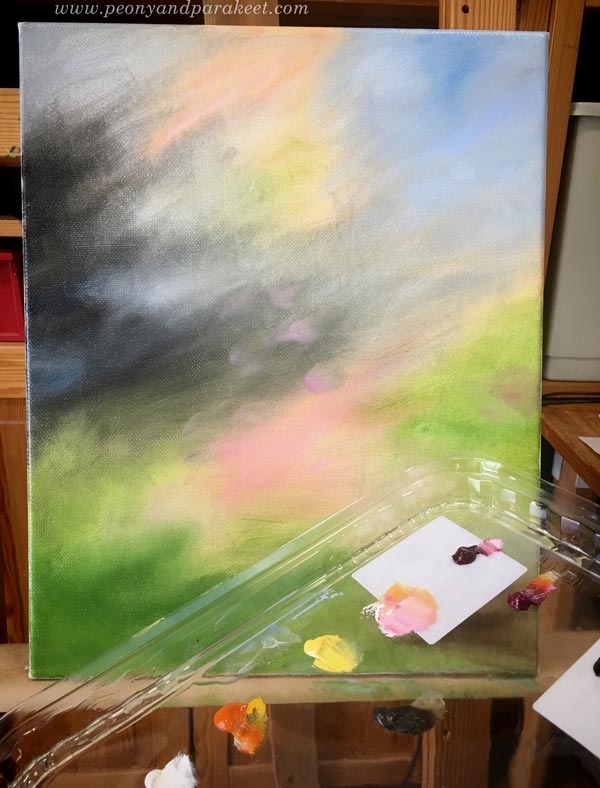
When painting abstract, I try to change the original idea to a mood, and then paint the mood. My mind is then in a 3-dimensional dynamic space rather than trying to maintain a 2-dimensional static image.
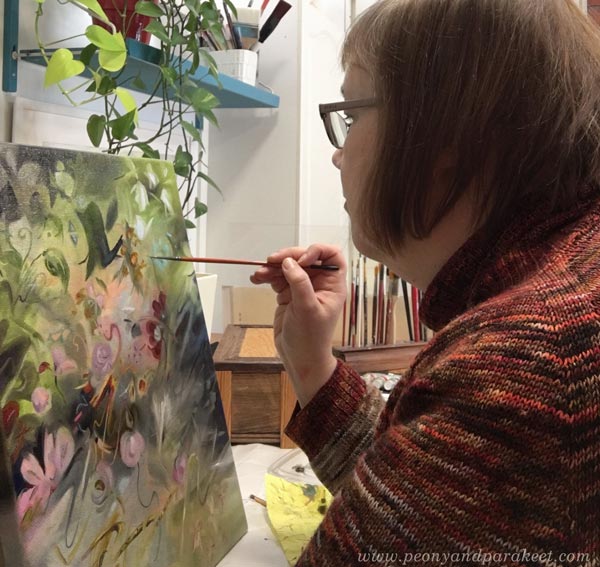
I think this tea party themed little painting turned out pretty well!
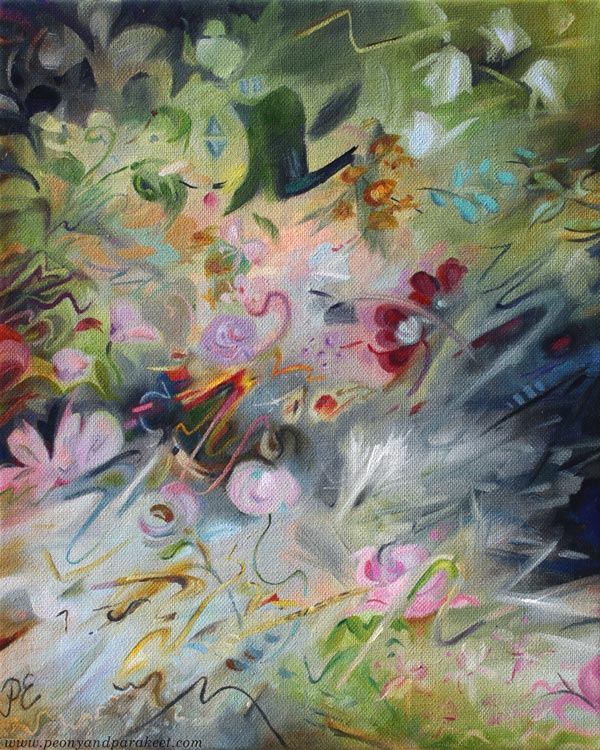
Art is a wonderland where you can do anything!
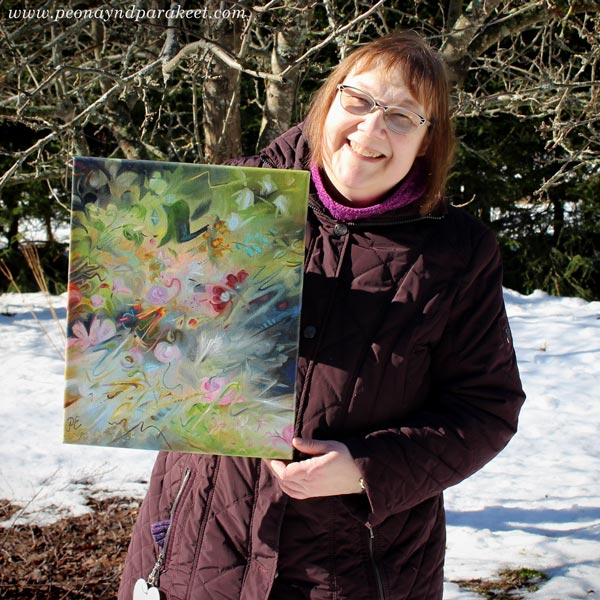
Here you can see the size of the painting better: 40 x 32 cm, about 15 3/4 and 12 1/2 inches.
Does Drawing Help for Loosening Up in Expression?
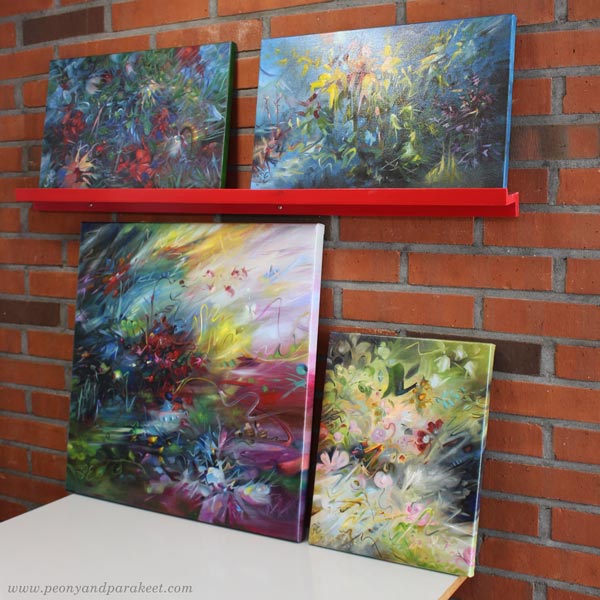
I have wondered if my abstract painting style would ever have been found without drawing figuratively. But I don’t think that would have happened. To become looser, it has been important to learn how reality works and how to express it with shapes.
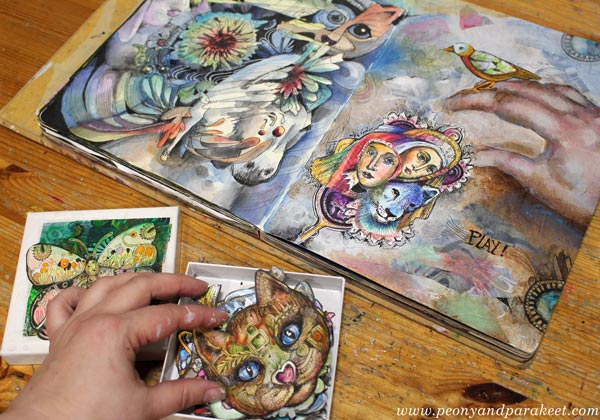
That’s why I’m really happy that my way to wonderland has been through a bend. And even that kind of a bend that I can share with the rest of you through the Magical Inkdom course among others.
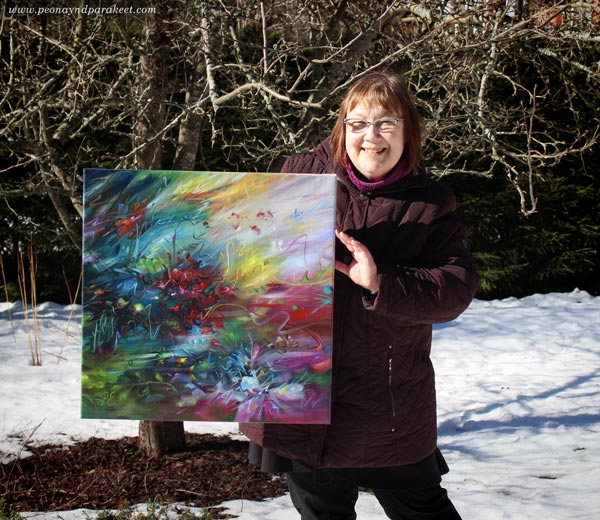
April 8-27, 2023, Kaninkolo group exhibition at Gallery Art Frida, Korkeavuorenkatu 25, Helsinki
Does Alice in Wonderland inspire you?
Drawing Inspiration – What I learned from Inspirational Drawing
This week, I have some drawing inspiration for you. Let’s celebrate our living line!
Recently, I heard the term “transition” and it resonated strongly. After receiving the grant from the Finnish Cultural Foundation, I have thought about my artistic career forward and at the same time also backward. I’ve noticed that it’s hard to think about the future without thinking about the past. I thought I’d write a few blog posts this spring about how I’ve grown my artistic skills by building courses.
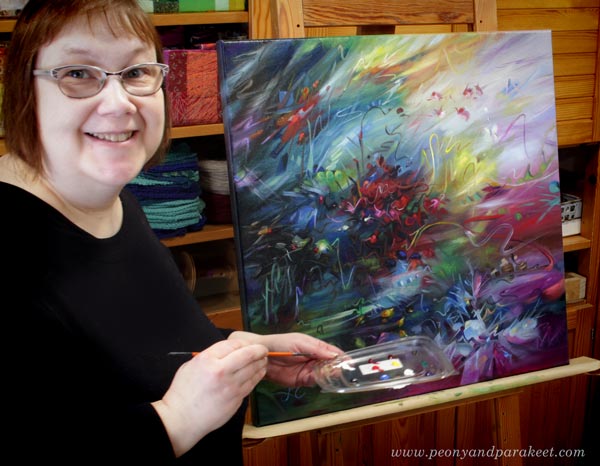
First, I want to talk about a course that formed the basis not only for everything I teach but also for how I paint today.
From Dots and Circles to a Living Line
Wassily Kandinsky (1866-1944) said “Everything starts from a dot.” On the same topic, Paul Klee (1879-1940) stated: “A line is a dot that went for a walk.” I think that when a person feels the call of fine art, he is at a point where he wants to get to know himself, to walk inward. I first went on a small tour only: I drew circles.
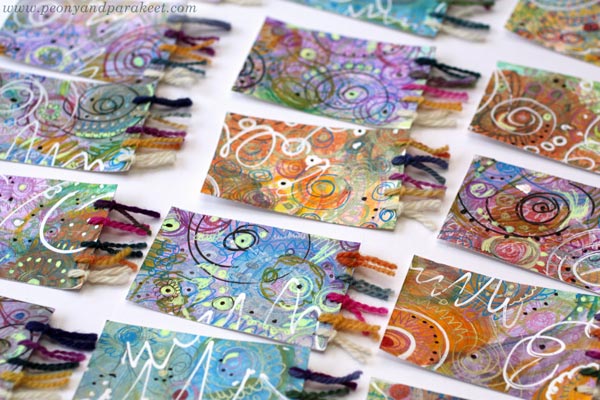
When I finally understood that I could open the circle and boldly move forward, a new world opened up. I saw my living line pulsating strongly. I felt I could draw anything and didn’t have to “know how to draw” to draw.
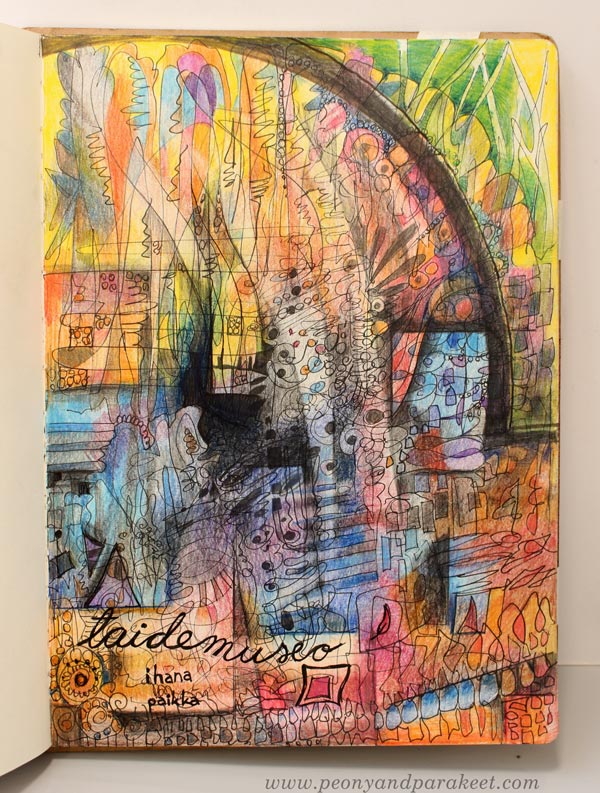
Fall in Love with Your Line
It became my calling to help people who are stuck and going around in circles move forward. In 2015, I first made a trial course for Finns called “Inspiroidu piirtämisestä” (Get inspired by drawing) and learned how to make an online course and clarify my points. Then, based on the Finnish course, I made an English version called Inspirational Drawing. When time passed and I got more experience, I made the same course a third time. In 2017, the most comprehensive version Inspirational Drawing 2.0 was born, which is also in my current course selection.
Inspirational Drawing is based on getting to know your own line. You don’t immediately remove your hand from the paper, but let the line travel a longer distance. This technique is commonly called “contour drawing”, but in my version, you don’t copy what is presented, but walk with your line and let the landscapes open up to the unpredictable.
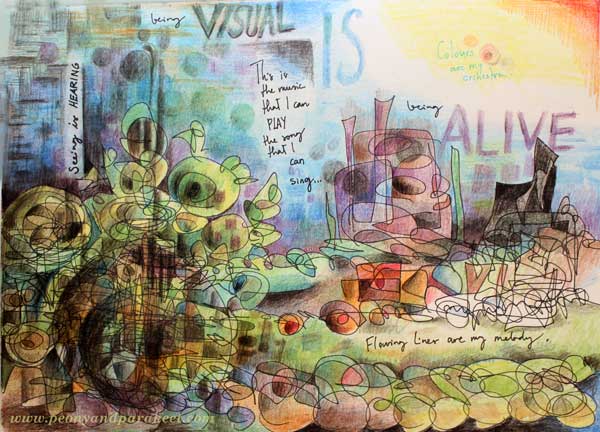
Your line is as unique as your signature. The most motivating thing in art-making is to fall in love with your line. When you want to repeatedly see your line and cherish it, it will also reveal its hidden potential. With your line, you can go much deeper in drawing inspiration and feel much freer than if you cut and compose collages from magazines or use stencils or stamps.
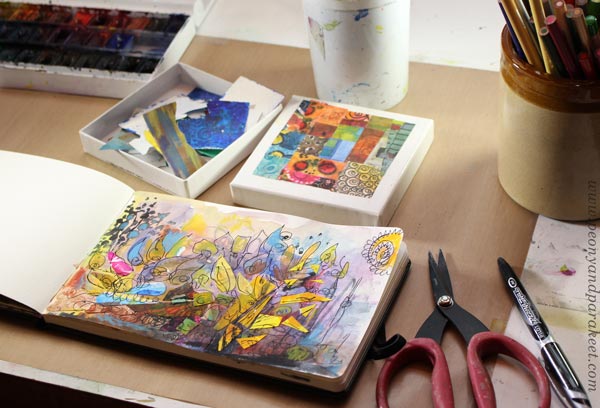
Drawing Inspiration
Inspiring pictures are also at the core of Inspirational Drawing. It’s natural for a creative person to collect pictures in one way or another, and drawing is a wonderful way to spend time with them. In the course, you will be guided to use the pictures you have chosen in drawing so that the pictures are not copied in the traditional style. To fuel free drawing, ideas are extracted from them. I still use this kind of inspiring effect of images in my painting process.
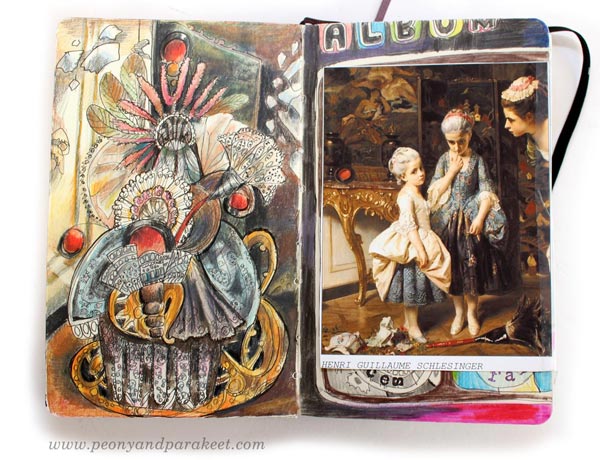
When moving from a point and closed shapes to an open, free-roaming line, inspiration has been a keyword anyway. With inspiration comes courage. It’s wonderful to draw when inspired. And it’s wonderful to inspire others with your own creative outcome.
Start Drawing!
Inspirational Drawing is now for sale this weekend, from March 15-19, 2023 (midnight PDT).
Inspirational Drawing – Get 20 % OFF – buy here!
3D Paper Collage of Hand-Drawn Art
This week, let’s play with hand-drawn paper pieces and create 3D collage art.
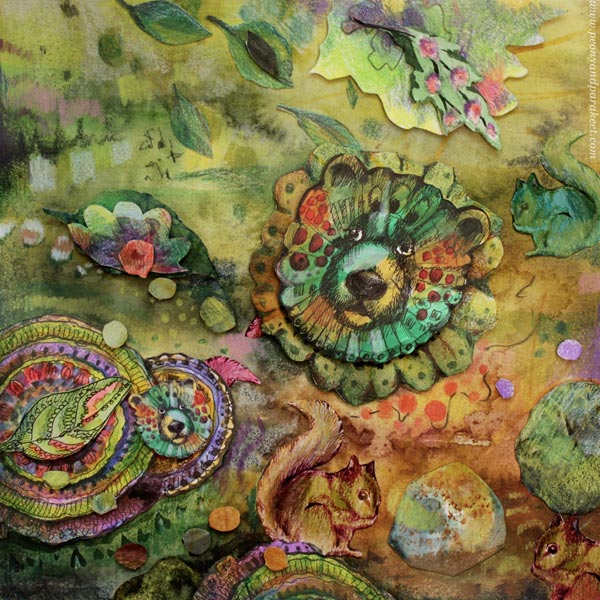
My example is eight by eight inches (about 20 x 20 cm), so fairly small, but it has quite a lot of details. I used foam tape to add dimension to it, and the result is lovely. It brings embroidery or applique to my mind.
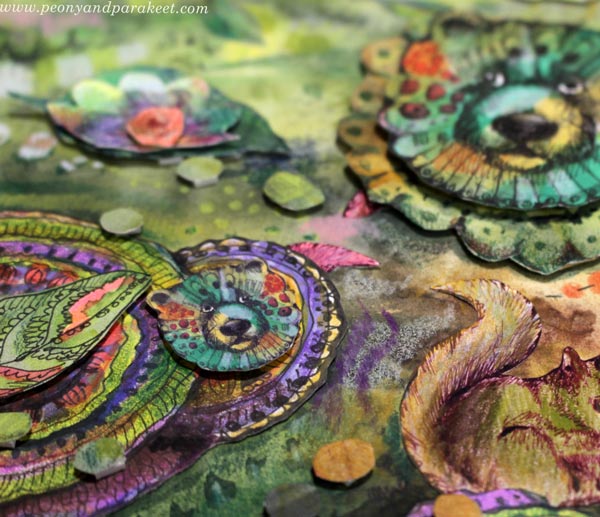
The idea of using foam tape between the layers is familiar to many from card-making, but I think the result is much more original when you use your own hand-drawn art.
Boxes of Joy – Shops Made by You for You
For years, I have been inspired by the idea of creating my own little paper shop. This shop is not about selling stuff for others but creative play where you are both a shop owner and its best customer. This picture is from 2016, when my shops were pretty simple and contained mostly paper sheets.
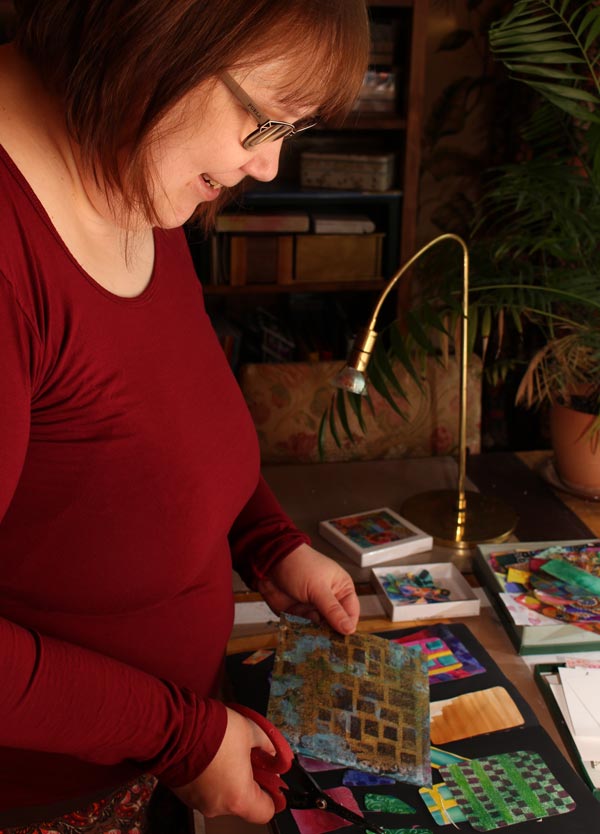
But the longer I have been in business, the more demanding my customer has got. I have got requests from myself to draw doodles, embroidery imitations, animals, magical stuff, flowers, dolls, and the little shops that I call boxes of joy have increased year by year and course by course.
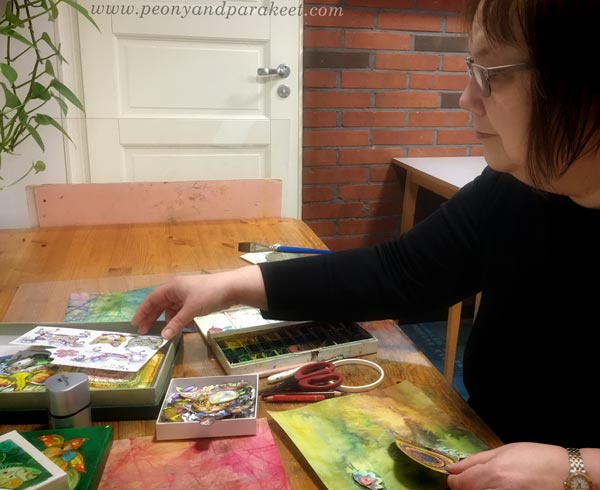
Sometimes the things I have drawn feel too precious to put to use. For example, the roses that I made for Doll World.
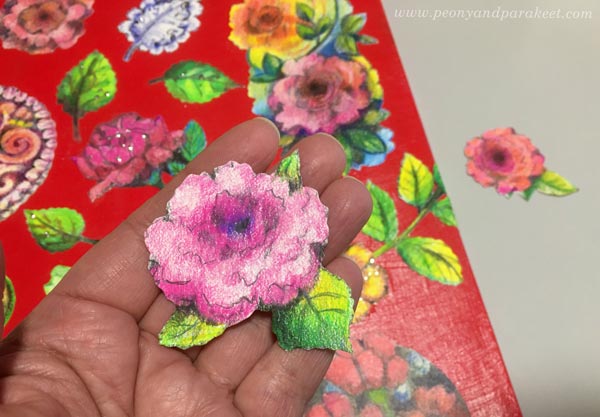
But the older the pieces get, the more I try to use them. And if something doesn’t “sell,” I can recolor it or add something to it so that I – my best customer – feel tempted to “buy” it.
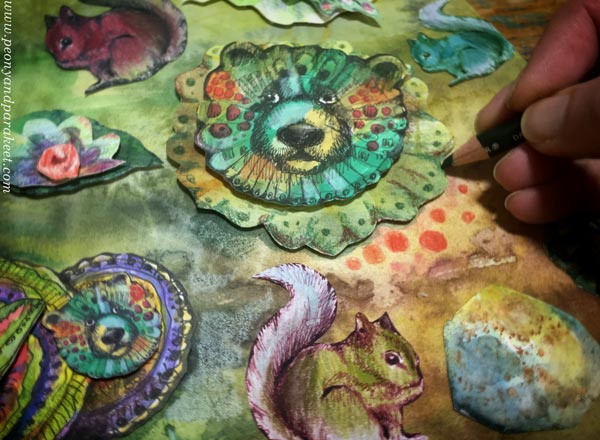
I like this process of adding more to something that’s pretty full already!
Thick Paper Love
One of my favorite papers is thick and smooth watercolor paper. It is suitable for both painting and drawing, but I sometimes avoid it because the collage gets so bulky. But for 3D effects, thick paper is perfect. It’s sturdy and goes very well with foam tape. Another paper that I like is Bristol paper. It’s not so thick but very smooth and sturdy enough for 3D.
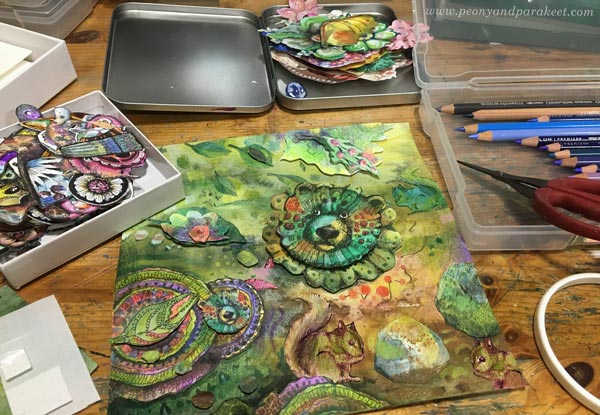
The background of this 3D paper collage is hand-painted watercolor paper. The elements are hand-drawn on watercolor paper or Bristol paper mostly.
Colored Pencils for 3D Paper Collage
Back in 2016, I used acrylic paints a lot. But nowadays, they feel less tempting. Not only because they are messier than colored pencils or watercolors but also because they are too similar to oil paints that I use for canvas paintings. I want to separate play from the pieces that I sell.
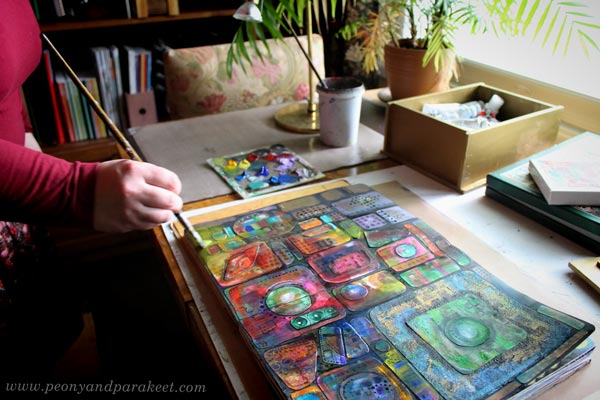
With play, I also want to grow my drawing skills. Colored pencils are great for that. They also go well together with watercolors. I have had a break with watercolors, but I hope to use them more this year.
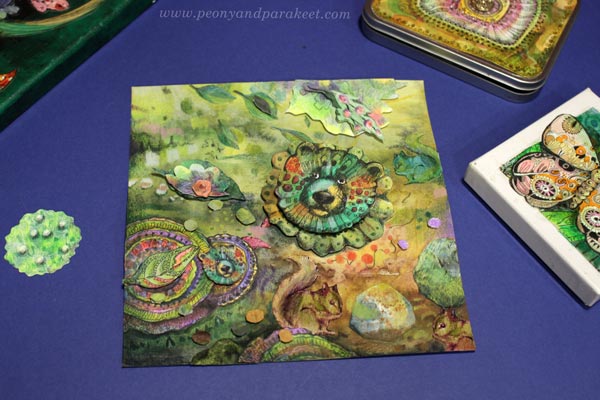
I like the many tones of green in this piece! I have colored many white parts with green to integrate the pieces better with the background.
Artist’s Life – Upcoming Projects
My playing time will get more limited soon because I will start a new series of oil paintings. I have been invited to a wonderful art history-related group exhibition that begins in August, and there is a smaller fantasy-related show in April. I will tell you more about these in the upcoming posts.
This spring is also full of art in other ways. I enjoy seeing all the lovely dolls from the participants of Doll World and other classes in my Bloom and Fly community. I hope to help you there as much as I can throughout the year. I am also participating in a Finnish artist coaching program to get to know the practices of the fine art world better. You have enabled my growth, and I hope that my growth will also benefit you. I hope that 2023 will be a good year of art for both of us.